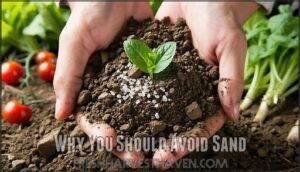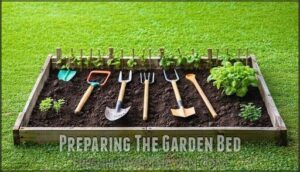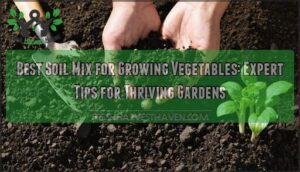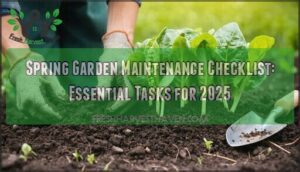This site is supported by our readers. We may earn a commission, at no cost to you, if you purchase through links.
 Learning how to amend clay soil for vegetable garden success starts with breaking up those tiny, packed particles that strangle plant roots. You’ll need to work in organic matter like compost or aged manure, aiming for about 30% by volume.
Learning how to amend clay soil for vegetable garden success starts with breaking up those tiny, packed particles that strangle plant roots. You’ll need to work in organic matter like compost or aged manure, aiming for about 30% by volume.
Test your soil’s drainage first—if water sits for hours after rain, you’ve got work ahead. Add gypsum to improve structure without changing pH levels. Work amendments into the top 12 inches when soil’s slightly moist, not soggy.
This transformation won’t happen overnight, but your patience pays off with nutrient-rich soil that holds moisture perfectly. The timing of these amendments makes all the difference.
Table Of Contents
- Key Takeaways
- Why is Clay Soil Challenging for Vegetables?
- Which Amendments Work Best for Clay Soil?
- How to Amend Clay Soil Step by Step
- When and How Often to Amend Clay Soil
- Maintaining Healthy Amended Soil
- Frequently Asked Questions (FAQs)
- What is the best way to amend clay soil?
- What is a good soil amendment for clay soil?
- How do you improve clay soil?
- Can you add organic matter to clay soil?
- Can clay soil be used as garden soil?
- Should you plant cover crops on clay soil?
- How can i Improve my clay soil?
- How to grow vegetables in clay soil?
- Can you add compost to clay soil?
- How to make clay soil better for vegetable garden?
- Conclusion
Key Takeaways
- Add 6-8 inches of organic matter like compost or aged manure to break up clay’s dense structure – you’ll need about 30% organic matter by volume worked into the top 12 inches for best results.
- Use gypsum instead of sand to improve drainage without changing your soil’s pH – sand creates concrete-like mixtures that make clay problems worse, not better.
- Time your amendments for fall or spring when soil’s moist but not waterlogged – you’ll get better incorporation and won’t damage the soil structure by working it when it’s too wet.
- Maintain your improved soil with annual additions of 2-4 inches of compost and proper mulching to prevent compaction from returning and keep your vegetables thriving long-term.
Why is Clay Soil Challenging for Vegetables?
You’ll quickly discover that clay soil creates a stubborn barrier between your vegetables and success.
Clay’s tiny particles pack together tightly, forming a dense mass that blocks water drainage and prevents oxygen from reaching plant roots, making it nearly impossible for vegetables to establish healthy root systems.
Common Characteristics of Clay Soil
Clay soil frustrates gardeners because of how it’s built – millions of microscopic plate-shaped particles that pack together like sheets of paper. These particles absorb water like crazy but won’t let it drain through easily.
Walk on wet clay and you’ll see the problem firsthand. Those tiny plates compress into a rock-hard mass that roots can’t penetrate. The soil becomes so dense that even earthworms struggle to move through it, throwing off the pH and making vegetable gardening feel impossible.
Problems Faced by Gardeners
Clay soil presents real challenges that can frustrate even experienced gardeners. The dense, packed earth creates a barrier that plant roots simply can’t break through. When water hits this compacted surface, it sits there instead of draining away, creating soggy conditions that suffocate roots.
- Plant roots hit a wall trying to push through tightly packed clay particles
- Water pools on the surface and around roots, creating waterlogged conditions
- Essential nutrients get trapped in the clay matrix, making them unavailable to plants
- Plants struggle to survive, leading to disappointing harvests despite your best efforts
Which Amendments Work Best for Clay Soil?
You’ll need the right amendments to transform your stubborn clay into productive garden soil.
Organic matter like compost and aged manure work best, while adding sand creates a concrete-like mess you’ll regret.
Organic Matter Options (Compost, Manure, Leaf Mold)
You’ll want to focus on three powerhouse organic matter types for transforming your clay soil.
Compost works like magic, breaking apart those stubborn clay particles while feeding beneficial soil microbes. Well-aged manure types—cow, horse, or chicken—provide slow-release organic fertilizers that vegetables love.
Leaf mold benefits include excellent water retention and natural soil structure improvement. These soil amendments create the perfect foundation for healthy plant growth.
Using Gypsum and Other Soil Conditioners
If you’re still struggling with clay soil after adding compost, gypsum delivers impressive results without messing with your soil’s pH.
This calcium powerhouse loosens those stubborn clay particles, improving drainage by up to 40% in just a few months. Spread 40-100 pounds over every 1,000 square feet once a year.
Other organic conditioners like biochar and perlite also improve clay stabilizers effectively. These lime alternatives deliver measurable gypsum benefits for vegetable gardeners. For best results, understanding soil conditioner benefits is essential for achieving a thriving garden ecosystem.
Why You Should Avoid Sand
Adding sand to clay soil creates amendment mistakes that lead to garden failures. Sand problems occur because tiny clay particles fill spaces between sand grains, forming concrete-like clay mixtures. This destroys soil structure instead of improving it.
Your soil composition becomes harder to work with, creating drainage issues worse than before. Skip sand when amending soil—organic matter works better.
How to Amend Clay Soil Step by Step
Now you’ll transform your clay soil from stubborn enemy to garden gold through three straightforward steps.
You can tackle this project in a single weekend, and your vegetables will thank you with healthier growth and better yields.
Preparing The Garden Bed
Understanding your soil sets the foundation for everything else. Get a soil test done to check your clay’s pH and nutrient levels before you start digging.
Plan out your bed layout and grab the right tools—you’ll need a spade, pitchfork, and garden rake for breaking up that clay.
- Test soil pH and drainage before starting any amendment work
- Choose tools like a spade, pitchfork, and garden rake for breaking clay
- Mark your garden bed boundaries and remove existing vegetation completely
- Wait for proper moisture conditions – soil should crumble, not stick together
- Clear debris and weeds to create a clean foundation for amending soil
Incorporating Amendments Properly
Now you’ll incorporate amendments properly. Spread organic soil amendments like compost across your prepared bed in a 6-8 inch layer.
Work these soil improvement materials into the top 12 inches using proper mixing techniques and tool selection. Don’t rush – thorough incorporating compost ensures even distribution.
Getting the amendment ratio right is crucial – you’ll want about 30% organic matter mixed into your soil for optimal plant health.
Manual Aeration Techniques
Once you’ve worked soil amendments in, grab your pitchfork for some serious aeration therapy. Drive aeration tools six inches deep, creating breathing holes throughout your clay soil. Space holes four inches apart—your vegetables’ roots will thank you.
This pitchfork aeration breaks compacted layers without destroying soil structure. Follow up with post-aeration care by adding a thin compost layer over freshly aerated areas.
When and How Often to Amend Clay Soil
You’ll get the best results by timing your clay soil amendments with nature’s schedule and your garden’s needs.
New beds require one deep amendment before planting, while established gardens benefit from annual shallow additions of 2-4 inches of organic matter each fall or spring.
Ideal Timing (Fall Vs. Spring)
Fall gives you the best shot at fixing clay soil. Cool weather slows down how fast organic matter breaks down, so amendments get months to work their magic before spring planting rolls around.
Timing matters—work the soil when it feels like a wrung-out sponge, not when it’s muddy. You can do this in spring too, but then you’re racing against planting season.
The real win happens when you work with nature’s schedule instead of against it.
Deep Amendment for New Beds
New garden beds need one-time deep soil improvement to break clay’s grip on your vegetables’ future. Initial amendment depth should reach 12 inches, incorporating 6-8 inches of organic matter throughout your garden bed. This aggressive approach creates lasting soil stabilization methods that’ll pay dividends for years.
- Dig deep – your roots will thank you later
- Mix thoroughly – half-hearted efforts yield half-hearted harvests
- Plant immediately after amending soil for stability
- Expect some settling as organic matter decomposes
First planting timing matters since fresh amendments need plant roots for soil stabilization. Setting expectations realistically, your garden bed may settle slightly, but long-term benefits include dramatically improved drainage and root penetration through previously impenetrable clay soil.
Annual Maintenance Tips
Once you’ve established your foundation, consistent amendment becomes your garden’s lifeline. Apply 2-4 inches of organic matter annually, keeping your soil testing schedule on track. Check soil drainage regularly and rotate crops to prevent nutrient depletion.
Amending soil yearly maintains structure, while proper watering of clay soil prevents compaction. Monitor weed control effectiveness—healthy amended soil naturally suppresses unwanted growth.
To improve soil quality, consider implementing soil management strategies for better results.
Maintaining Healthy Amended Soil
Once you’ve transformed your clay soil, you’ll need consistent care to maintain its improved structure and fertility.
Regular mulching, proper watering practices, and annual soil monitoring will keep your vegetable garden thriving for years to come.
Mulching and Cover Cropping
Mulching your amended clay soil acts like a protective blanket, keeping organic matter intact while preventing soil erosion. Apply organic mulching materials like compost or leaf mold around your vegetables.
Cover crops between growing seasons add nitrogen and break up compacted layers through their root systems. Rotate these cover crop benefits with different mulch types to optimize soil health and maintain your hard-earned improvements.
Preventing Compaction and Overwatering
Beyond mulching, smart water management keeps your amended clay soil thriving. Clay soil’s water retention means less frequent watering but careful timing. Walk on designated paths to prevent compaction and protect delicate root zones.
Once you’ve got your clay soil properly amended, the next challenge is keeping water from becoming your enemy or your plants’ worst nightmare.
- Create permanent walkways – Your roots will thank you for staying off their turf
- Water deeply but infrequently – Clay soil holds moisture like a sponge
- Install raised beds – Give your vegetables the high ground they deserve
- Add stepping stones – Navigate your garden without soil aeration damage
- Check soil moisture first – Stick your finger 2 inches deep before watering clay soil
Monitoring Soil Health Year-Round
Regular soil testing becomes your garden’s health report card, revealing nutrient deficiencies and pH issues before they damage crops. Annual pH monitoring and nutrient cycling assessments help maintain soil fertility.
Check soil drainage after heavy rains and monitor microbial balance through simple visual cues like earthworm activity. Preventing erosion control problems is crucial to protect your improved clay structure.
Frequently Asked Questions (FAQs)
What is the best way to amend clay soil?
Transform your stubborn clay into garden gold by adding 6-8 inches of organic matter like compost or aged manure.
Work it into the top 12 inches during fall or spring when soil’s moist but not waterlogged for best results.
What is a good soil amendment for clay soil?
You’ll want compost as your go-to amendment. It’s like giving clay soil a makeover – breaking up those stubborn particles while feeding your plants.
Add aged manure or leaf mold for extra punch.
How do you improve clay soil?
You’ll break up compacted clay by adding 6-8 inches of organic matter like compost or aged manure. Work it into the top 12 inches during fall or spring when soil’s moist but not waterlogged.
Can you add organic matter to clay soil?
Like mixing chocolate chips into cookie dough, you can absolutely add organic matter to clay soil.
Adding organic matter to clay soil transforms dense, compacted earth into fertile ground where vegetables can thrive
Compost, aged manure, and leaf mold work into clay’s dense structure, creating air pockets and improving drainage for healthier vegetable roots.
Can clay soil be used as garden soil?
Clay soil can absolutely work for your vegetable garden, but you’ll need to improve its drainage and structure first. Add organic matter like compost to release its nutrient-rich potential.
Should you plant cover crops on clay soil?
Yes, you should plant cover crops on clay soil. They’re powerful soil healers that break up compaction naturally.
Daikon radishes penetrate deep, creating channels for air and water. Legumes add nitrogen while their roots improve structure organically.
How can i Improve my clay soil?
Think of your clay soil as stubborn clay that needs gentle coaxing.
Add 6-8 inches of organic matter like compost or aged manure annually. Work it into the top foot during fall or spring when soil’s moist but not waterlogged.
How to grow vegetables in clay soil?
You’ll need patience with clay soil, but vegetables can thrive here. Add 6-8 inches of compost annually, work it into the top foot, and plant immediately.
Choose raised beds for better drainage and root development.
Can you add compost to clay soil?
You can transform stubborn clay into fertile ground by adding compost. Mix 2-4 inches annually into the top 6-12 inches.
This magic ingredient breaks up compacted particles, improves drainage, and feeds your vegetables naturally.
How to make clay soil better for vegetable garden?
Add 6-8 inches of compost, aged manure, or leaf mold to your clay soil. Work it into the top 12 inches, then plant immediately to stabilize the structure.
Conclusion
You’ve figured out how to turn clay soil into something your vegetables will actually love. It takes patience and the right approach, but it works.
Your investment in organic matter, gypsum, and careful timing will pay off for years. Soil improvement takes time—there’s no rushing it.
Keep adding compost each year, stay off wet beds, and watch your vegetables thrive in soil that finally drains well and gives roots room to breathe.
- https://books.tenthacrefarm.com/the-permaculture-inspired-vegetable-garden/?utm_source=taf&utm_campaign=TPIVG2&utm_medium=banner1-link
- https://learningandyearning.com/fall-leaves-a-valuable-soil-builder
- https://pickyourown.org/countyextensionagentoffices.htm
- https://gardentabs.com/should-add-sand-to-clay-soil/
- https://extension.oregonstate.edu/news/clay-soil-challenges-solutions-oregon-gardeners











